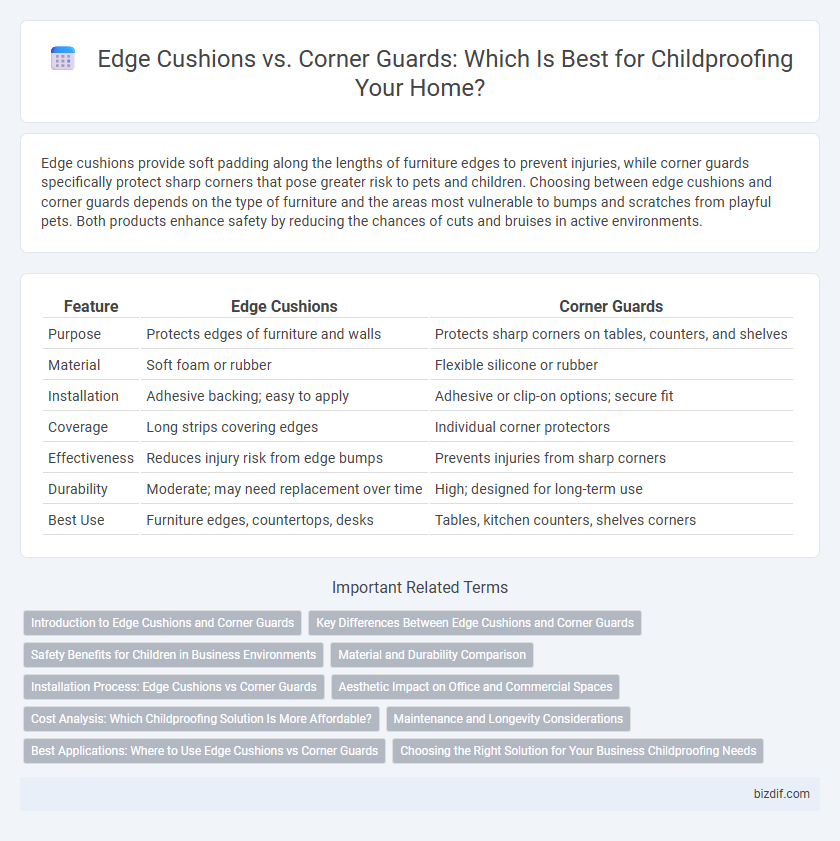Edge cushions provide soft padding along the lengths of furniture edges to prevent injuries, while corner guards specifically protect sharp corners that pose greater risk to pets and children. Choosing between edge cushions and corner guards depends on the type of furniture and the areas most vulnerable to bumps and scratches from playful pets. Both products enhance safety by reducing the chances of cuts and bruises in active environments.
Table of Comparison
| Feature | Edge Cushions | Corner Guards |
|---|---|---|
| Purpose | Protects edges of furniture and walls | Protects sharp corners on tables, counters, and shelves |
| Material | Soft foam or rubber | Flexible silicone or rubber |
| Installation | Adhesive backing; easy to apply | Adhesive or clip-on options; secure fit |
| Coverage | Long strips covering edges | Individual corner protectors |
| Effectiveness | Reduces injury risk from edge bumps | Prevents injuries from sharp corners |
| Durability | Moderate; may need replacement over time | High; designed for long-term use |
| Best Use | Furniture edges, countertops, desks | Tables, kitchen counters, shelves corners |
Introduction to Edge Cushions and Corner Guards
Edge cushions and corner guards are essential childproofing products designed to prevent injuries from sharp furniture edges. Edge cushions typically cover long, straight edges such as table sides, while corner guards specifically protect the sharp corners of furniture pieces like countertops and cabinets. Both products are made from soft, impact-absorbing materials like foam or rubber, ensuring maximal safety for children in the home.
Key Differences Between Edge Cushions and Corner Guards
Edge cushions are designed to cover the sharp edges of furniture, providing a soft barrier to prevent injuries, while corner guards specifically protect protruding corners that pose a high risk of impact. Edge cushions typically run along the length of a surface, offering continuous protection, whereas corner guards are compact and fit tightly around corners for targeted safety. Both are essential in childproofing, but selecting between them depends on the furniture shape and the type of hazard present.
Safety Benefits for Children in Business Environments
Edge cushions provide comprehensive protection by covering entire edges, reducing the risk of cuts and bruises for children in business environments, while corner guards specifically shield sharp corners, preventing impact injuries. Both products are essential in enhancing child safety, especially in spaces with high foot traffic and hard furniture, ensuring compliance with safety regulations. Incorporating edge cushions and corner guards minimizes liability risks and creates a secure, child-friendly atmosphere in professional settings.
Material and Durability Comparison
Edge cushions are typically made from soft foam or rubber materials that provide flexible impact absorption and are ideal for covering longer edges, while corner guards are often constructed from rigid plastic or silicone, designed to fit snugly around sharp corners for enhanced protection. Foam edge cushions offer excellent shock absorption but may wear out faster under frequent contact, whereas durable silicone corner guards resist cracking and maintain their protective qualities over time. Choosing between the two depends on the specific areas to childproof and the desired balance between flexibility and long-lasting durability.
Installation Process: Edge Cushions vs Corner Guards
Edge cushions typically feature adhesive backing or Velcro strips for straightforward installation along furniture edges, ensuring a snug fit to absorb impacts. Corner guards often require precise placement on sharp corners and may use strong double-sided tape or mounting brackets for secure attachment. Both products aim for easy, tool-free installation, allowing parents to quickly childproof hazardous areas without professional assistance.
Aesthetic Impact on Office and Commercial Spaces
Edge cushions offer a softer, more integrated look that blends seamlessly with office furniture, maintaining professional aesthetics in commercial spaces. Corner guards, while providing robust protection, tend to be more visible and can disrupt the sleek design of modern office interiors. Selecting edge cushions can enhance safety without compromising the visual appeal of work environments, supporting a balance between functionality and style.
Cost Analysis: Which Childproofing Solution Is More Affordable?
Edge cushions typically offer a more affordable childproofing solution compared to corner guards, with prices generally ranging from $10 to $20 per set, depending on material quality and brand. Corner guards, while often more durable and effective at preventing injuries from sharp edges, can cost between $15 and $30 per set, making them a slightly higher investment. Choosing between edge cushions and corner guards involves weighing the initial cost against long-term durability and safety effectiveness to determine the most cost-efficient option for home childproofing.
Maintenance and Longevity Considerations
Edge cushions require regular cleaning with mild soap and water to maintain their softness and prevent dirt buildup, while corner guards often need less frequent maintenance due to their durable plastic or rubber construction. Over time, edge cushions may show signs of wear such as compression or tears, necessitating periodic replacement to ensure continued protection. Corner guards typically offer longer longevity as their rigid materials resist impact and environmental damage better than foam-based cushions.
Best Applications: Where to Use Edge Cushions vs Corner Guards
Edge cushions are best applied along the lengths of furniture edges such as tables, countertops, and shelves to protect children from sharp, exposed surfaces. Corner guards are ideal for securing the pointed edges of coffee tables, cabinets, and desks where collisions are most likely to cause injury. Both safety products are essential for comprehensive childproofing in high-traffic areas of living rooms, kitchens, and playrooms.
Choosing the Right Solution for Your Business Childproofing Needs
Edge cushions provide soft padding along entire edges, ideal for protecting children from sharp furniture boundaries, while corner guards specifically shield the most vulnerable sharp corners. Businesses specializing in childproofing should assess the types of furniture and areas most frequented by children to determine whether edge cushions or corner guards offer comprehensive safety. Selecting the right solution enhances overall child safety and meets varying client requirements in commercial childproofing environments.
Edge Cushions vs Corner Guards Infographic

 bizdif.com
bizdif.com